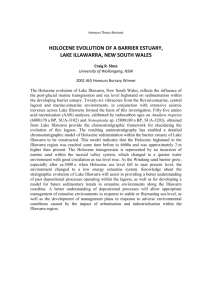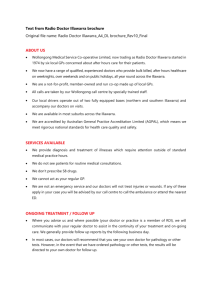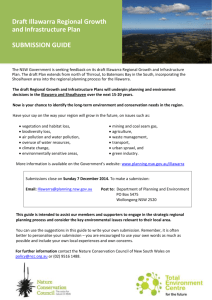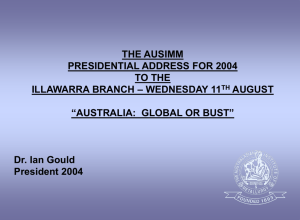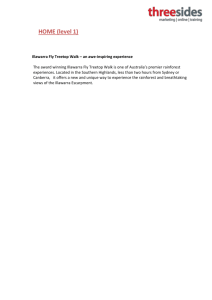20110407futurebounty - Australian Koala Foundation
advertisement
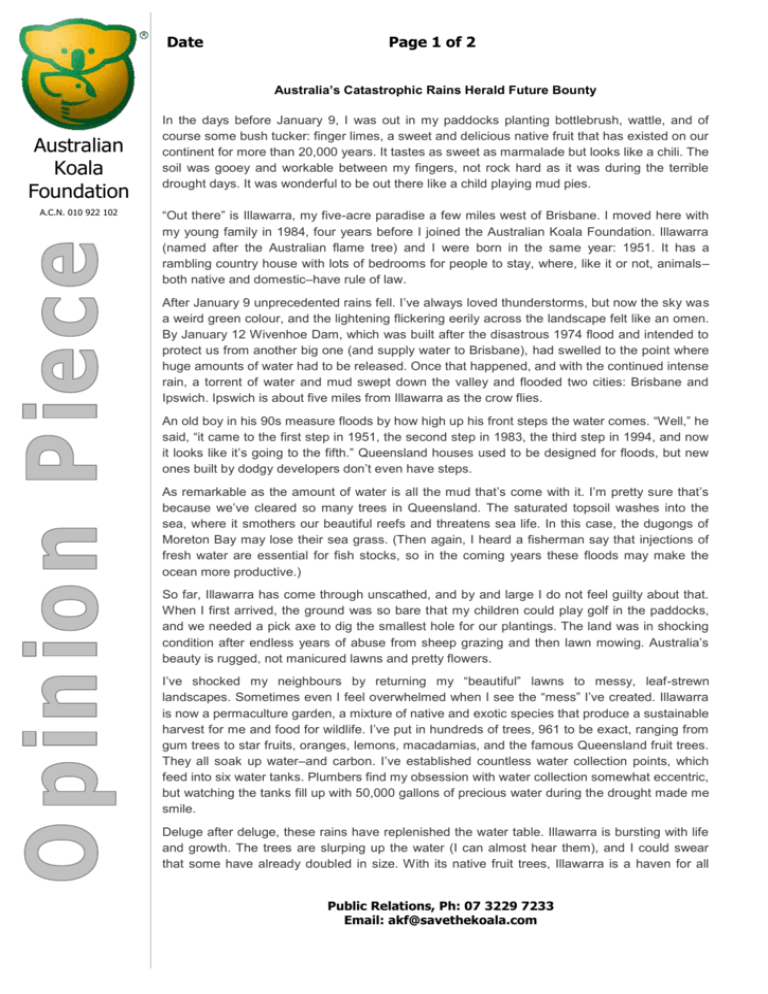
Date Page 1 of 2 Australia’s Catastrophic Rains Herald Future Bounty Australian Koala Foundation A.C.N. 010 922 102 In the days before January 9, I was out in my paddocks planting bottlebrush, wattle, and of course some bush tucker: finger limes, a sweet and delicious native fruit that has existed on our continent for more than 20,000 years. It tastes as sweet as marmalade but looks like a chili. The soil was gooey and workable between my fingers, not rock hard as it was during the terrible drought days. It was wonderful to be out there like a child playing mud pies. “Out there” is Illawarra, my five-acre paradise a few miles west of Brisbane. I moved here with my young family in 1984, four years before I joined the Australian Koala Foundation. Illawarra (named after the Australian flame tree) and I were born in the same year: 1951. It has a rambling country house with lots of bedrooms for people to stay, where, like it or not, animals– both native and domestic–have rule of law. After January 9 unprecedented rains fell. I’ve always loved thunderstorms, but now the sky was a weird green colour, and the lightening flickering eerily across the landscape felt like an omen. By January 12 Wivenhoe Dam, which was built after the disastrous 1974 flood and intended to protect us from another big one (and supply water to Brisbane), had swelled to the point where huge amounts of water had to be released. Once that happened, and with the continued intense rain, a torrent of water and mud swept down the valley and flooded two cities: Brisbane and Ipswich. Ipswich is about five miles from Illawarra as the crow flies. An old boy in his 90s measure floods by how high up his front steps the water comes. “Well,” he said, “it came to the first step in 1951, the second step in 1983, the third step in 1994, and now it looks like it’s going to the fifth.” Queensland houses used to be designed for floods, but new ones built by dodgy developers don’t even have steps. As remarkable as the amount of water is all the mud that’s come with it. I’m pretty sure that’s because we’ve cleared so many trees in Queensland. The saturated topsoil washes into the sea, where it smothers our beautiful reefs and threatens sea life. In this case, the dugongs of Moreton Bay may lose their sea grass. (Then again, I heard a fisherman say that injections of fresh water are essential for fish stocks, so in the coming years these floods may make the ocean more productive.) So far, Illawarra has come through unscathed, and by and large I do not feel guilty about that. When I first arrived, the ground was so bare that my children could play golf in the paddocks, and we needed a pick axe to dig the smallest hole for our plantings. The land was in shocking condition after endless years of abuse from sheep grazing and then lawn mowing. Australia’s beauty is rugged, not manicured lawns and pretty flowers. I’ve shocked my neighbours by returning my “beautiful” lawns to messy, leaf-strewn landscapes. Sometimes even I feel overwhelmed when I see the “mess” I’ve created. Illawarra is now a permaculture garden, a mixture of native and exotic species that produce a sustainable harvest for me and food for wildlife. I’ve put in hundreds of trees, 961 to be exact, ranging from gum trees to star fruits, oranges, lemons, macadamias, and the famous Queensland fruit trees. They all soak up water–and carbon. I’ve established countless water collection points, which feed into six water tanks. Plumbers find my obsession with water collection somewhat eccentric, but watching the tanks fill up with 50,000 gallons of precious water during the drought made me smile. Deluge after deluge, these rains have replenished the water table. Illawarra is bursting with life and growth. The trees are slurping up the water (I can almost hear them), and I could swear that some have already doubled in size. With its native fruit trees, Illawarra is a haven for all Public Relations, Ph: 07 3229 7233 Email: akf@savethekoala.com Date Page 2 of 2 manner of creatures: bats, sugar gliders, and a hundred species of birds. And of course, the annoying mosquitoes and sand flies that find their way under my mosquito net at night. Australian Koala Foundation A.C.N. 010 922 102 Many Australian animals need trees with hollows in them. But these can take up to 300 years to form, so while I wait, I’ve put out hollow logs. Each year I watch as different species of marsupials or birds fight over who will occupy them. Ringtail possums normally build bowers in trees, but for some reason during these drenching days, one ringtail has taken the unconventional step of encroaching on a hollow used by a “brushy.” You have to giggle when at around 4 a.m. you hear two tiny little nocturnal animals fighting it out, then sprinting across the tin roof in a race to the hollow. They sound as if they’re wearing hobnail boots. To my delight during a break in the rain, I found 16 butterfly caterpillars on a single citrus tree waiting to go into their cocoons. Soon Illawarra will be awash in butterflies–blue ones, white ones, yellow ones, red ones–whose names I don’t yet know. Some will fly in and out of the house–the doors are always open. As I write, the kookaburras, sulphur-crested cockatoos, galahs, magpies, rosellas, and king parrots are trilling away, a chorus punctuated by the screeches of cockatoos, often called the bushman’s alarm clock. I’m extraordinarily lucky that Illawarra hasn’t been in the path of a crushing wall of water, like other places in Queensland. Humans have suffered terribly, and the word catastrophe is apt. Families are torn by grief. Coal mines are full of water, industrial railways ruined, cotton crops destroyed. The toll on domestic animals–particularly horses, cows, and sheep–has been grievous too. The creatures I live with are thriving. Although I’ve seen pictures of fleeing possums, kangaroos (some in rowboats), and snakes, I’ve heard surprisingly little about the koalas. I have a feeling they’re doing quite well in their lofty tree houses. One supporter sent this note: “We are on Redbank Creek, which on Monday burst its banks and swallowed up large trees and sandstone boulders the size of small cars before flooding the township. We have made it home to our property today to find 3 koalas snuggly sitting in trees within 150m of each other. It was reassuring to see them.” We had another huge thunderstorm over Illawarra last night, and I lay in bed waiting for a tree that had been hit by lightning to fall on my bedroom. I feel a little overwhelmed at the enormity of it all. I am not unscathed emotionally, but as I look out the window at my beautiful piece of the world, I understand that all this water is essential for the future of this amazing country of ours. I hope that as we listen to the pounding rains, we hear the message this ancient land is giving: We must learn to live in harmony with nature. As the water subsides, there will be beauty again. Public Relations, Ph: 07 3229 7233 Email: akf@savethekoala.com

